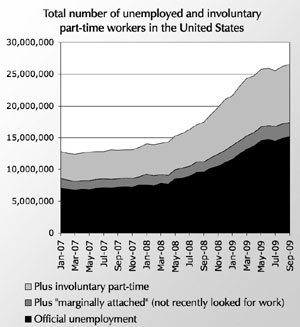

Vol. 73/No. 40 October 19, 2009

|
Various efforts by the capitalist rulers to “stimulate” their profit system through prods at consumer spending have already revealed their futility, lending further proof that the crisis is not a product of bad policy, but a more fundamental one created by the natural workings of the world capitalist system.
The official unemployment rate rose from 9.7 percent in August to 9.8 percent in September. While the sharp spike in joblessness began to slow in May, the trend has continued upward.
The combined rate of real joblessness and underemployment—what the Bureau of Labor Statistics calls its “U-6 alternative measure of labor underutilization”—has risen for 20 of the last 22 months and now stands at 17 percent. This includes unemployed workers not counted in the official figure who the government claims have not looked for a job over the past month, as well as those working part-time because they can’t find full-time work.
As a result of the tendency under capitalism for the rate of profit to decline over time, a trend that has marked the last four decades, bosses are faced with more output than they can sell at a profit—a crisis of so-called overproduction. This drives ever more cutthroat competition among capitalists worldwide and a shift from investment in production to increased speculation and mounting debt—now a bursting bubble of fictitious capital.
Under these conditions the expanding reserve pool of labor has served the bosses by fueling competition for jobs and providing a lever to hold down wages and intensify the pace of work.
Unions, for the most part, have put up little resistance, the consequence of decades of class collaboration by the top labor officialdom with the bosses and their government. Labor Department figures on strikes involving more than 1,000 workers have dropped markedly from 21 in 2007, to 15 in 2008, to 2 so far this year.
The revised figures on the second quarter of 2009, released early in September, show a decline of 1.5 percent in the annual rate of output along with a 7.6 percent decline in hours worked, compared to the previous quarter. This means that only a little less is being produced with a lot fewer workers working less hours, resulting in an increase of 6.6 percent in the annual rate of “productivity.” This represents the largest increase since 2003. As a result, unit labor costs for the bosses fell by nearly 6 percent.
‘Cash for clunkers’ fails to ‘stimulate’
After government tax rebates failed to generate spending, the capitalist economic wizards took a more direct approach with a “cash for clunkers” program that offered up to $4,500 trade-in value for scrapping old working cars to buy new ones.
The fleeting boost this $3 billion program gave to the auto industry through late August is over and rapidly being reversed. The longer-term effect on the industry and overall capitalist economy is nil at best. The 0.2 percent decrease in fuel consumption per year through the purchase of more fuel efficient cars is negligible—and the “good news for the environment” ignores the impact of 700,000 needlessly junked automobiles.
Overall auto sales fell by 23 percent in September compared to the previous year. GM and Chrysler sales were both more than 40 percent lower. Of all the car manufacturers in the world, only the lower-priced Hyundai and Kia Motors saw any increase in sales last month.
For the moment a number of auto factories are busy replacing depleted inventory. To be sure the bosses are preparing further layoffs for the not-too-distant future to match slumping demand once the lots are restocked.
And now the government is preparing a similar $300 million program to temporarily boost sales of new home appliances.
Front page (for this issue) |
Home |
Text-version home